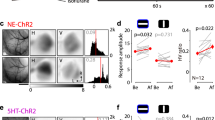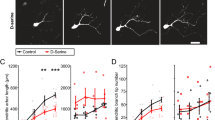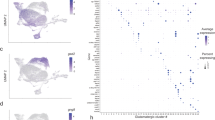Abstract
Early visual experience is essential in the refinement of developing neural connections. In vivo whole-cell recording from the tectum of Xenopus tadpoles showed that repetitive dimming-light stimulation applied to the contralateral eye resulted in persistent enhancement of glutamatergic inputs, but not GABAergic or glycinergic inputs, on tectal neurons. This enhancement can be attributed to potentiation of retinotectal synapses. It required spiking of postsynaptic tectal cells as well as activation of NMDA receptors, and effectively occluded long-term potentiation (LTP) of retinotectal synapses induced by direct electrical stimulation of retinal ganglion cells. Thus, LTP-like synaptic modification can be induced by natural visual inputs and may be part of the underlying mechanism for the activity-dependent refinement of developing connections.
This is a preview of subscription content, access via your institution
Access options
Subscribe to this journal
Receive 12 print issues and online access
$209.00 per year
only $17.42 per issue
Buy this article
- Purchase on Springer Link
- Instant access to full article PDF
Prices may be subject to local taxes which are calculated during checkout






Similar content being viewed by others
References
Katz, L. C. & Shatz, C. J. Synaptic activity and the construction of cortical circuits. Science 274, 1133–1138 (1996).
Penn, A. A., Riquelme, P. A., Feller, M. B. & Shatz, C. J. Competition in retinogeniculate patterning driven by spontaneous activity. Science 279, 2108–2112 (1998).
Crowley, J. C. & Katz, L. C. Development of ocular dominance columns in the absence of retinal input. Nat. Neurosci. 2, 1125–1130 (1999).
Wiesel, T. N. & Hubel, D. H. Single cell responses in striate cortex of kittens deprived of vision in one eye. J. Neurophysiol. 26, 1003–1017 (1963).
LeVay, S., Stryker, M. P. & Shatz, C. J. Ocular dominance columns and their development in layer IV of the cat's visual cortex: a quantitative study. J. Comp. Neurol. 179, 223–244 (1978).
LeVay, S., Wiesel, T. N. & Hubel, D. The development of ocular dominance columns in normal and visually deprived monkeys. J. Comp. Neurol. 191, 1–51 (1980).
Stryker, M. P. & Harris, W. A. Binocular impulse blockade prevents the formation of ocular dominance columns in cat visual cortex. J. Neurosci. 6, 2117–2133 (1986).
Weliky, M. & Katz, L. C. Disruption of orientation tuning in visual cortex by artificially correlated neuronal activity. Nature 386, 680–685 (1997).
Crair, M. C., Gillespie, D. C. & Stryker, M. P. The role of visual experience in the development of columns in cat visual cortex. Science 279, 566–570 (1998).
Rittenhouse, C. D., Shouval, H. Z., Paradiso, M. A. & Bear, M. F. Monocular deprivation induces homosynaptic long-term depression in visual cortex. Nature 397, 347–350 (1999).
Fawcett, J. W. & Willshaw, D. J. Compound eyes project stripes on the optic tectum in Xenopus. Nature 296, 350–351 (1982).
Udin, S. B. Abnormal visual input leads to development of abnormal axon trajectories in frogs. Nature 301, 336–338 (1983).
Reh, T. A. & Constantine-Paton, M. Eye-specific segregation requires neural activity in three-eyed Rana pipiens. J. Neurosci. 5, 1132–1143 (1985).
Schmidt, J. T. & Buzzard, M. Activity-driven sharpening of the retinotectal projection in goldfish: development under stroboscopic illumination prevents sharpening. J. Neurobiol. 24, 384–99 (1993).
Bliss, T. V. & Lømo, T. Long-lasting potentiation of synaptic transmission in the dentate area of the anaesthetized rabbit following stimulation of the perforant path. J. Physiol. (Lond.) 232, 331–356 (1973).
Malenka, R. C. & Nicoll, R. A. Long-term potentiation—a decade of progress? Science 285, 1870–1874 (1999).
Perkins, A. T. & Teyler, T. J. A critical period for long term potentiation in the developing rat visual cortex. Brain Res. 439, 222–229 (1988).
Komatsu, Y., Fujii, K., Maeda, J., Sakaguchi, H. & Toyama, K. Long-term potentiation of synaptic transmission in kitten visual cortex. J. Neurophysiol. 59, 124–141 (1988).
Artola, A., Bröcher, S. & Singer, W. Different voltage-dependent thresholds for inducing long-term depression and long-term potentiation in slices of rat visual cortex. Nature 347, 69–72 (1990).
Mooney, R., Madison, D. V. & Shatz, C. J. Enhancement of transmission at the developing retinogeniculate synapse. Neuron 10, 815–825 (1993).
Crair, M. C. & Malenka, R. C. A critical period for long-term potentiation at thalamo-cortical synapses. Nature 375, 325–328 (1995).
Zhang, L. I., Tao, H. W., Holt, C. E., Harris, W. A. & Poo, M. A critical window for cooperation and competition among developing retinotectal synapses. Nature 395, 37–44 (1998).
Cline, H. T. & Constantine-Paton, M. NMDA receptor antagonists disrupt the retinotectal topographic map. Neuron 3, 413–426 (1989).
Scherer, W. J. & Udin, S. B. N-methyl-D-aspartate antagonists prevent interaction of binocular maps in Xenopus tectum. J. Neurosci. 9, 3837–3843 (1989).
Bear, M. F., Kleinschmidt, A., Gu, Q. A. & Singer, W. Disruption of experience-dependent synaptic modifications in striate cortex by infusion of an NMDA receptor antagonist. J. Neurosci. 10, 909–925 (1990).
Schmidt, J. T. Long-term potentiation and activity-dependent retinotopic sharpening in the regenerating retinotectal projection of goldfish: common sensitive period and sensitivity to NMDA blockers. J. Neurosci. 10, 233–246 (1990).
Hahm, J. O., Langdon, R. B. & Sur, M. Disruption of retinogeniculate afferent segregation by antagonists to NMDA receptors. Nature 351, 568–570 (1991).
Simon, D. K., Prusky, G. T., O'Leary, D. D. & Constantine-Paton, M. N-methyl-d-aspartate receptor antagonists disrupt the formation of a mammalian neural map. Proc. Natl. Acad. Sci. USA 89 10593–10597 (1992).
Schlaggar, B. L., Fox, K. & O'Leary, D. D. Postsynaptic control of plasticity in developing somatosensory cortex. Nature 364, 623–626 (1993).
Li, Y., Erzurumlu, R. S., Chen, C., Jhaveri, S. & Tonegawa, S. Whisker-related neuronal patterns fail to develop in the trigeminal brainstem nuclei of NMDAR1 knockout mice. Cell 76, 427–437 (1994).
Aamodt, S. M. & Constantine-Paton, M. The role of neural activity in synaptic development and its implications for adult brain function. Adv. Neurol. 79, 133–144 (1999).
Kirkwood, A., Rioult, M. C. & Bear, M. F. Experience-dependent modification of synaptic plasticity in visual cortex. Nature 381, 526–528 (1996).
Kirkwood, A., Lee, H. K. & Bear, M. F. Co-regulation of long-term potentiation and experience-dependent synaptic plasticity in visual cortex by age and experience. Nature 375, 328–331 (1995).
Rogan, M. T., Staubli, U. V. & LeDoux, J. E. Fear conditioning induces associative long-term potentiation in the amygdala. Nature 390, 604–607 (1997).
Oda, Y., Kawasaki, K., Morita, M., Korn, H. & Matsui, H. Inhibitory long-term potentiation underlies auditory conditioning of goldfish escape behaviour. Nature 394, 182–185 (1998).
Moser, E. I., Krobert, K. A., Moser, M.-B. & Morris, R. G. M. Impaired spatial learning after saturation of long-term potentiation. Science 281, 2038–2042 (1998).
Rioult-Pedotti, M. S., Friedman, D., Hess, G. & Donoghue, J. P. Strengthening of horizontal cortical connections following skill learning. Nat. Neurosci. 1, 230–234 (1998).
Xu, L., Anwyl, R. & Rowan, M. J. Spatial exploration induces a persistent reversal of long-term potentiation in rat hippocampus. Nature 394, 891–894 (1998).
Hamill, O. P., Marty, A., Neher, E., Sakmann, B. & Sigworth, F. J. Improved patch-clamp techniques for high-resolution current recording from cells and cell-free membrane patches. Pflugers Arch. 391, 85–100 (1981).
Rae, J., Cooper, K., Gates, P. & Watsky, M. Low access resistance perforated patch recordings using amphotericin B. J. Neurosci. Methods 37, 15–26 (1991).
Nieuwkoop, P. D. & Faber, J. Normal Table of Xenopus Laevis 2nd edn. (North Holland, Amsterdam, 1967).
Gaze, R. M., Keating, M. J. & Chung, S. H. The evolution of the retinotectal map during development in Xenopus. Proc. R. Soc. Lond. B. 185, 301–330 (1974).
Holt, C. E. & Harris, W. A. Order in the initial retinotectal map in Xenopus: a new technique for labelling growing nerve fibres. Nature 301, 150–152 (1983).
Edwards, J. A. & Cline, H. T. Light-induced calcium influx into retinal axons is regulated by presynaptic nicotinic acetylcholine receptor activity in vivo. J. Neurophysiol. 81, 895–907 (1999).
Ben-Ari, Y., Khazipov, R., Leinekugel, X., Caillard, O. & Gaiarsa, J. L. GABAA, NMDA and AMPA receptors: a developmentally regulated ‘ménage à trois’. Trends Neurosci. 20, 523–529 (1997).
Lettvin, J. Y., Maturana, H. R., McCulloch, W. S. & Pitts, W. H. What the frog's eye tells the frog's brain. Proc. Inst. Radio Eng. 47, 1950–1961 (1959).
Bi, G.-q. & Poo, M.-m. Synaptic modifications in cultured hippocampal neurons: dependence on spike timing, synaptic strength, and postsynaptic cell type. J. Neurosci. 18, 10464–10472 (1998).
Engert, F. & Bonhoeffer, T. Dendritic spine changes associated with hippocampal long-term synaptic plasticity. Nature 399, 66–70 (1999).
Maletic-Savatic, M., Malinow, R. & Svoboda, K. Rapid dendritic morphogenesis in CA1 hippocampal dendrites induced by synaptic activity. Science 283, 1923–1927 (1999).
Acknowledgements
We thank G. Bi, Y. Dan, W. Harris, C. Holt and F. Engert for suggestions. This work was supported by a grant from the National Science Foundation.
Author information
Authors and Affiliations
Corresponding author
Rights and permissions
About this article
Cite this article
Zhang, L., Tao, Hz. & Poo, Mm. Visual input induces long-term potentiation of developing retinotectal synapses. Nat Neurosci 3, 708–715 (2000). https://doi.org/10.1038/76665
Received:
Accepted:
Issue Date:
DOI: https://doi.org/10.1038/76665
This article is cited by
-
The effects of the NMDAR co-agonist d-serine on the structure and function of optic tectal neurons in the developing visual system
Scientific Reports (2023)
-
A computational study of multisensory maturation in the superior colliculus (SC)
Experimental Brain Research (2011)
-
In vivo single-cell excitability probing of neuronal ensembles in the intact and awake developing Xenopus brain
Nature Protocols (2010)
-
PTX-induced hyperexcitability affects dendritic shape and GABAergic synapse density but not synapse distribution during Manduca postembryonic motoneuron development
Journal of Comparative Physiology A (2009)
-
Stabilization of motor asymmetry in the goldfish under the influence of optokinetic stimulation
Neurophysiology (2008)



